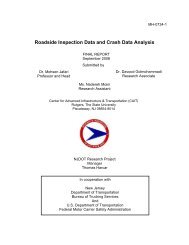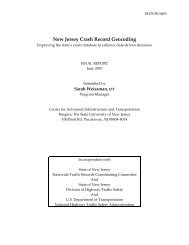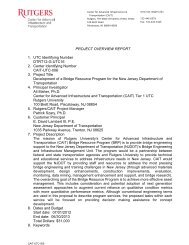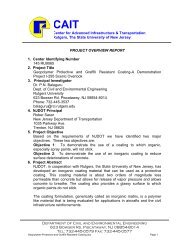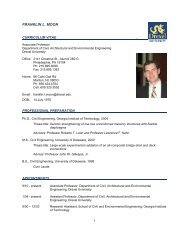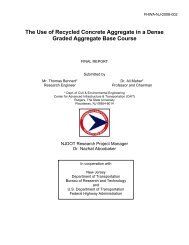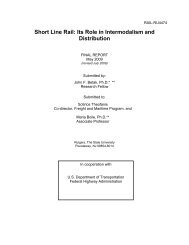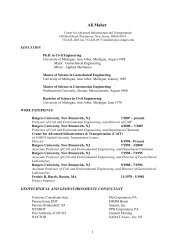Download this report - CAIT - Rutgers, The State University of New ...
Download this report - CAIT - Rutgers, The State University of New ...
Download this report - CAIT - Rutgers, The State University of New ...
Create successful ePaper yourself
Turn your PDF publications into a flip-book with our unique Google optimized e-Paper software.
Chapter 2: <strong>The</strong> dTIMS CT Database<br />
2.2 Attributes<br />
In the previous section Perspectives were described as objects that are used to contain<br />
groups <strong>of</strong> assets with similar characteristics. <strong>The</strong> next step in a database design is to define<br />
the characteristics you want to describe within each Perspective. <strong>The</strong>se characteristics are<br />
called Attribute objects in dTIMS CT.<br />
Attribute objects allow you to define the asset characteristics you want to store in each<br />
Perspective. In the analogy where Perspectives are thought <strong>of</strong> as tables, Attributes can<br />
represent the columns (fields) in each <strong>of</strong> the tables.<br />
Table 12 to Table 42 in Appendix “A” list the attributes defined in each perspective listed in<br />
Table 1.<br />
Each Attribute table in Appendix “A” lists the Perspective to which the Attributes belong to,<br />
the Attribute Name, a short description <strong>of</strong> the Attribute (as it appears in dTIMS CT) and the<br />
Attribute Type.<br />
Attributes • Attribute Type<br />
Every attribute you create is assigned a specific data type, which determines the kind <strong>of</strong> data values<br />
that can be entered into an attribute’s cell. Attribute Type is important when designing your database<br />
because once you create an attribute in dTIMS CT you cannot change its type. It is important to note<br />
that dTIMS CT displays data values for attribute types in the format that you have specified in your<br />
Windows | Regional Settings. When you create an attribute, you will need to specify one <strong>of</strong> the<br />
following data types:<br />
Data Type Characteristics Benefit<br />
Integer<br />
• Referred to as the Short<br />
Integer.<br />
• Whole numbers<br />
positive and negative and<br />
• Space saving<br />
• Good for storing small values<br />
NJDOT Deighton dTIMS CT User Manual 27



